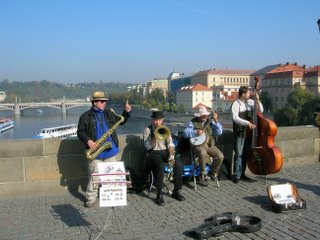There's something I've been meaning to ask some of the Indian bloggers. I ran into a copy of VS Naipaul's An Area of Darkness in a bookshop over the weekend. Incredibly well-written, as Naipaul's books usually are, but bleak and typically bilious. What I was interested in discussing though was how the India described in the book, the India of the 60's, compares to India today. How do Indian readers feel about the book and the verities of Naipaul's observations? And how have the attitudes and perceptions described in the book evolved since the book was written?I have not read the book. If any of you has, it would be wonderful if you could leave a comment in response to his questions. Thank you.
Wednesday, November 30, 2005
V.S. Naipaul's An Area of Darkness
Monday, November 28, 2005
Of Gods and Demons
Calvin and Tintin and Asterix and Obelix on the one hand and tales of the Dashaavathara, Ramayana and Mahabharatha on the other.
Over the weekend, he was narrating the story of Lord Narasimha, Hiranyakashipu and Prahalad to his grandparents and eventually he came to the question of why gods and demons always seemed to be fighting.
He answered his own question and said the demons were fighting to take over god's lands. Then he said, nodding wisely, "Yeah, the demons wanted Kerala because it's god's own country."
Wednesday, November 23, 2005
To Everyone That Celebrates Thanksgiving...
Prague: A Little City With a Big Heart
Then suddenly, as we followed the gentle curve of the road down a slope, we saw Prague on the other side of the two-way street beyond a low-lying stone wall. The view lasted thirty seconds before the trees and the stone wall rose to block the view entirely, but we'd caught a glimpse of what was in store.
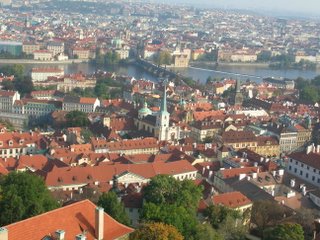 Prague nestles around the Vltava
Prague nestles around the VltavaThe late afternoon sun lay shimmering on the blue expanse of the Vlatava and lent a golden glow to the bright orange roofs. Steeples and spires and chimneys rose above, and neat little rectangular windows peeped from underneath the roofs.
The taxi drove on and soon Prague presented itself in all its splendor as we crossed one of the 16 bridges across the Vlatava to our hotel. We checked in, had an early dinner and turned in to get over the jet lag that was catching up.
The next morning, fortified by a hearty breakfast and light jackets, N and I collected a walking map from the concierge, left V to attend to work and headed out toward Prague's Old Town Square. We walked about twenty paces out of the hotel and headed right back in. The cold air quickly penetrated our poor defences.
Ten minutes and an additional layer of sweaters and caps later, we found ourselves passing a couple of modern office buildings and under the highway that skirted our hotel. Paved roads gave way to cobbled streets. A brisk ten-minute walk on Na Porici, a broad two-way street broken in the middle by tram tracks and lined by old buildings converted into stores and apartments led us to this,
the Municipal House. As we approached it, we saw young men and women handing out flyers. I took one of them and saw announcements for concerts. They were performances of pieces by Mozart, Beethoven, Dvorak, Handel. I looked regretfully at the man who handed me the flyer, pointed to N and shook my head, "Sorry, we can't go. We have our son with us." He said, "No problem, children are free."
What? I did a double take. A western classical music concert in a place like that and they not only allowed children, but for free? He nodded. So we took a few more flyers and happily continued on our walk to the Old Town Square promising ourselves that we would make time for one of those performances.
Right next to the Municipal House is the 15th century Powder Tower built originally to serve as an entrance to the Old Town and later comissioned to hold gun powder during conflicts in the 17th century (hence the name).
 The Powder Tower led us into Old Town where we found this restaurant with outside seating.
The Powder Tower led us into Old Town where we found this restaurant with outside seating. The owner had thoughtfully lined the seats with fur. Looked very inviting to our cold, aching feet, but it was'nt lunch time yet.
The owner had thoughtfully lined the seats with fur. Looked very inviting to our cold, aching feet, but it was'nt lunch time yet. So we pressed on and came to this open air market that's open every day and stocks everything from flowers to wooden toys to clothes and condiments. We bought two kinds of fudge at the shop above.
So we pressed on and came to this open air market that's open every day and stocks everything from flowers to wooden toys to clothes and condiments. We bought two kinds of fudge at the shop above.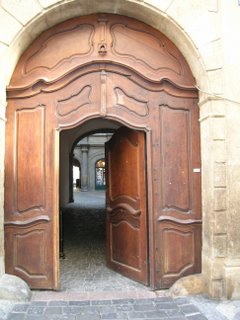 We passed by and passed through many doorways such as these on our way to the Square. We had walked into the building through the far doorway and found ourselves in a big courtyard with the center open to the sky. When we walked out the little passage we saw this.
We passed by and passed through many doorways such as these on our way to the Square. We had walked into the building through the far doorway and found ourselves in a big courtyard with the center open to the sky. When we walked out the little passage we saw this.It was obvious that the Czech took immense pride in their city and their buildings. The centuries old facades of their buildings were scupulously maintained. We saw scaffoldings and construction sheets on many of the buildings. Apparently the maintenance works go on all around the year except during the winters and during peak tourist season.
The city streets always wore a just-swept look. One sight that was memorable was the one of two city workers carefully prying cigarette butts out of the millions of crevices on the cobbled streets with their brooms on to the pans.
And there were many, many cigarette butts. As we walked around, we saw so many people smoking that N blurted out, with his palm against his nose, "Mama, this is such a smoking city!"
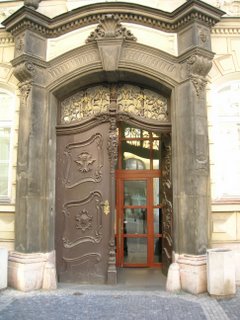
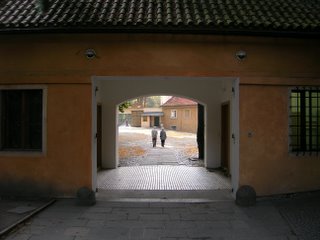
The city is also replete with narrow streets such as those below.

It is so easy to imagine Sir Lancelot galloping up this street or villagers click-clacking their way up and down these streets in their wooden clogs.

We meandered our way through the doorways and the streets and came here, to the Old Town Square.
The Church in the background is the Church of Our Lady in Front of Tyn which is where Tyco Brahe is apparently buried.
If anything vies with the cleanliness of the city for my admiration, it is the fact that this little country produced so many luminaries - Antonin Dvorak, Bedrich Smettana, Franz Kafka, Vaclav Havel, Milan Kundera - and their achievements (at least those of the musicians) are celebrated in the numerous concerts that take place every day to packed houses. We came across more men and women handing out flyers for more concerts in more concerts halls as we continued our walk. More about the concert we attended in another post.
Another thrilling discovery was the pleasure of riding on the roads of the Czech Republic. We took two day trips, one to the west of Prague to the hotwater springs of Karlovy Vary (Karlsbad) and one in the region of Bohemia to the splendid castle at Cesky Krumlov. More about these road trips in another post as well.
At the end of the first morning in Prague, after about three hours of walking, we found ourselves at the Rudolfinum, the home of the Czech National Orchestra.
Some of the names in Prague - Centrum, Rudolfinum, Klementinum (the University) are very evocative of Asterix and Obelix!
We tried to take a tram back to the hotel but found that we had to buy tickets in advance at one of the metro stations or at newspaper stands.

So we trudged back and tried to follow a straight line back to the hotel which was hopelessly unsuccessful. We got so lost that towards the end we were walking on the very narrow sidewalk on the highway near the hotel than under it.
But by early evening, we had recovered sufficiently to head out again, with V this time. We took at taxi to the Prague Castle.
 The facade of the castle as seen from one of the bridges across the moat
The facade of the castle as seen from one of the bridges across the moat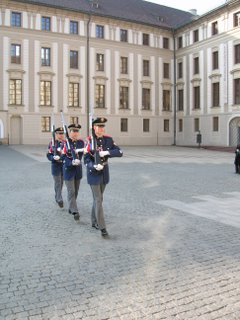
The 14th Century St. Vitus' Cathedral is an integral part of the castle. The beautiful stained glass windows and the high ceilings are awe-inspiring.
 As we made our rounds of the cathedral and prepared to head out, we saw an arrow pointing up one of the towers. 287 steps later (N climbed up every single one of them, but V had him on his shoulders on the way back), we were amply rewarded with spectacular views of the city.
As we made our rounds of the cathedral and prepared to head out, we saw an arrow pointing up one of the towers. 287 steps later (N climbed up every single one of them, but V had him on his shoulders on the way back), we were amply rewarded with spectacular views of the city.
 The Dome of St. Nicholas Church
The Dome of St. Nicholas ChurchOne of the most interesting streets in Prague is Golden Lane within the Prague Castle grounds. Originally built for the palace guards, the tiny houses along Golden Lane were eventually taken over by goldsmiths giving the street its present name,
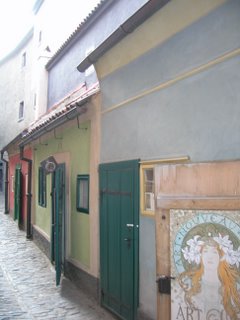


and still later by some well-known writers, including Franz Kafka who apparently lived in House No. 22 for a few months. The houses are so tiny they are almost claustrophobic. Now these houses have been converted to shops that sell trinkets, books and souvenirs for the thousands of tourists who pass by here every day.
 We walked down a long slope of steps from the castle back to the city. Tiny shops such as this one sellling wooden toys and art work line one side of the steps.
We walked down a long slope of steps from the castle back to the city. Tiny shops such as this one sellling wooden toys and art work line one side of the steps.
There is music everywhere in Prague. Two violonists and a cellist serenaded patrons at a restaurant just past the Powder Tower. We asked them to play "Volare" and they played "I Did it My Way". I don't know if there was a hidden message in that....
 Charles Bridge, the most famous of the 16 bridges that straddle the Vlatava, connects Old Town with Mala Strana, the Little Quarter that nestles just below the Prague Castle. The bridge was originally built without any of the statues and successive kings added the statues as they saw fit.
Charles Bridge, the most famous of the 16 bridges that straddle the Vlatava, connects Old Town with Mala Strana, the Little Quarter that nestles just below the Prague Castle. The bridge was originally built without any of the statues and successive kings added the statues as they saw fit. The most famous and sought after statue on Charles Bridge is the one of St. John Nepomuk. He was apparently arrested for having displeased the king, tortured and then thrown over the bridge. A legend says that if you wish to return to Prague, then you should touch the dog at the base of that statue.
The most famous and sought after statue on Charles Bridge is the one of St. John Nepomuk. He was apparently arrested for having displeased the king, tortured and then thrown over the bridge. A legend says that if you wish to return to Prague, then you should touch the dog at the base of that statue. Well, the smooth, burnished apperance of the dog should be some indication of how popular that legend is.
Well, the smooth, burnished apperance of the dog should be some indication of how popular that legend is.For the record, all three of us touched the statue. To echo N's words, Prague is smokin'!
Monday, November 21, 2005
Shantaram
How can one man withstand all that? And then write about it with such love, compassion, empathy and understanding of the human condition?
Wednesday, November 09, 2005
Passion for Service Finds Market Niche
Kekelwa Dall was listening to the radio one day in early 2002 when she heard a news report on the 2000 census and the growing class of senior citizens. Something clicked in her mind. “I thought, well, they need services.”
With a graduate degree in Population Studies and Demographics, experience working for a large corporation in Zambia, her native country, and a major portion of her professional life spent working in social services (at the United Nations, the World Bank and other international development agencies, and as a social worker and volunteer), she realized she had a business concept.
From that moment in 2002 when she heard the radio report, to now, two years later, her story is a case study in how a small business gets off the ground, and could serve as a road map for other entrepreneurs looking to start a small business.
Once she had “generated this seed of interest…in doing my own business,” she went to the Fairfax County Business Center to investigate available resources. The program manager at the Center’s Office for Women walked her through the federal, state and county level resources.
She also directed Kekelwa to the Women’s Business Center (WBC) in Fairfax County and George Mason University’s (GMU) Business Enterprise Center, both of which offered classes on the mechanics of starting a business.
She initially took the classes offered at GMU. Although she had no quarrel with GMU’s classes in terms of their content, Kekelwa found herself gravitating more towards the WBC. At GMU, most of the entrepreneurs were male, and from the high-tech sector, and talking about “big, big sums” of money. “If you end up there, fine, but that was intimidating.”
Kekelwa says she felt more comfortable at the WBC because there were more female entrepreneurs there, and the WBC was a “nurturing place … for people who are starting with very small capital.”
She took the classes they offered on preparing business plans, marketing plans and financial plans, and on the mechanics of setting up a business. She also attended their networking events. It was at one of those events that she came to know of the Enterprise Development Group in Arlington through which she obtained a business loan.
Although the classes and events at the WBC carried fees, she says they were a fraction of what she would pay at commercial centers offering the same types of classes. “Forty-five dollars for a whole day’s workshop, it was definitely very cost-effective,” she says.
As a result of the time and the little bit of money she invested in educating herself on how to be an entrepreneur, she developed the fortitude to revise her business plan when circumstances called for it, and learned that obstacles are but a part of doing business.
Her biggest obstacle, she says, is being a small business in an industry inundated by large, established corporations. The question the start-up classes taught her to ask was “What are you offering that other businesses are not offering?” She found that many of her potential senior clients wanted to stay in their own homes rather than move to a senior living facility, or come home quickly (in the case of hospitalized patients) rather than prolong their expensive stays in the hospital. So she crafted a niche for her business – providing care in her clients’ homes.
When she reviewed the business plan and the various elements of her business – her potential clients, the nurses and nurse-aides she used as contractors to provide the services to her clients – she realized that there was a mismatch in terms of her available resources and the segment of the population she wanted to serve.
On the one hand, her research showed that although it was a growing population, in northern Virginia, only seven percent of the population was 65 years or older. On the other hand, her contract nurses and nurse-aides are licensed to care for people, whether they are seniors or non-seniors. She realized “we were boxing ourselves into [a small] segment of the population by just focusing on seniors.”
So in June 2003, she changed the focus of her business to include any group in terms of age, and renamed it (from Kendal Seniors Care, LLC to Kendal Home Care, LLC) to reflect the change. Kendal Home Care now provides non-medical home care services and the company’s objective is to include home health care services. Seniors, as well as people who are recuperating at home after being discharged from hospitals, make up her client base.
As a small business, the lack of resources can be incredibly difficult at times. At one point, Kendal Home Care had to suspend its services when it was caught in a tussle between her insurance carrier and the Virginia Department of Health. The insurance company refused to augment her malpractice coverage to where the Health Department said it should be. It took nearly four months for the issue to be successfully resolved, and it tested her will to continue with her business.
Kekelwa took heart in the stories of other businesswomen she heard at networking meetings and in the lessons taught at the WBC. For this reason, she highly recommends becoming a member of trade associations and women’s networking groups, such as the National Association of Women Business Owners. One such networking episode (she contacted other women running home care agencies so she could learn about their businesses) lead to “some very positive interaction,” and she ended up sub-contracting for one of those agencies.
When asked what makes her want to come to work everyday, she says it’s definitely not the money – because as a small business, she does not expect profit in the first two years – but her interest in the field, her faith in what she is doing, and the value of the service she provides. It’s almost as if this were her calling.
This article (the third in my series on women-owned businesses in Northern Virginia) originally appeared in the Times Community Newspapers.
Monday, November 07, 2005
Beyond Blogging: Volunteering at Akshara
Saturday, November 05, 2005
Life is Beautiful
At one point, N had had enough of it. He clearly demarcates between "Indian Food" (rice, idlis, dosa, chapati, curries, sambhar) and "American Food" (pbj sandwiches, pancakes, pasta, cereal) and if he's had, let's say, idlis for breakfast, and rice and sambhar for lunch, then he flat out asks for American Food for dinner.
So after a couple of times of eating at the wedding, just as we were going into dinner, he asked to go home. He was tired. We had just returned from an overseas trip and he was recovering from a bad cough. Plus, at home, he could have pasta for dinner.
I hesitated. What will the relatives think? How will it look if I took off just as everyone was getting ready to sit together for dinner?
On the other hand, I really did not want to force N to stay if he did not want to. I could have imposed my will and made him stay. But why? He wasn't making a fuss. He was making logical arguments about why we should go home ("Mom, I'm tired." "Mom, look how bad my cough is," followed by a demonstration for my benefit.) I looked at N's pleading eyes and decided we were leaving.
We flagged down an auto and headed home. As we were riding back home he said, "Thanks Mom. Are you upset because we had to leave early?" I said he was welcome and of course not, I was'nt upset but glad he told me what he wanted to do. The relief on his face was palpable.
On the one hand I was thrilled that he had said thank you, but on the other hand was feeling wretched that he was feeling relieved and thankful at all. He was just being a five year old and I should be as understanding as I was in that instance every day, every instance.
But I'm not. Quite often other considerations creep in. I have my inspired moments, moments that would warrant a Mother of the Year award, if there were one, but those moments are rarer than I would like.
It is in those moments when I can see myself being a monster that I remember the movie Life is Beautiful.
Life is Beautiful is a movie about many things. It is a movie about the holocaust. It is a movie about the spirit of one man defying the might of the German war machine. It is a movie about love, about persistence. It is a movie about resilience.
Above all, it is a movie about parenting.
It is a movie about a father who, in the midst of all the misery and terror of a concentration camp, in the midst of the horrors taking place around him, never loses sight of the perspective of his young son.
Just so the little boy should not feel fear, the father pretends that the entire concentration camp experience is an elaborate game, translating the stentorian orders of the German soldiers into loud Italian (and not being faithful to the original German of course), pretending that the whole thing is an elaborate game of cops and robbers, a game of hide and seek.
I know it's just a movie and that in real life, practical considerations abound. But it's an insipiration nonetheless.
If you haven't already seen the movie, please do. Just make sure you have a box of tissues next to you when you do. And your favourite pjs, blankie and your favourite corner of the sofa will certainly help. We had some indication of the sadness the movie evoked as we watched the people from the previous showing walk out of the theater. But we had no idea until we watched the movie ourselves. When the movie ended, no one got out of their seats. People just sat and sobbed quietly.
Wednesday, November 02, 2005
Childbirth: Preparation is Key
As soon as I settled down on my bed in the hospital where I would deliver my baby, I looked around my room. I spied a beautiful white flower in a painting hanging on the wall across from me, and decided the flower would be my “focal point.” I would focus on that flower whenever I felt a contraction coming on, a technique I learned at my childbirth class.
When I was first pregnant with my son, I thought I knew how I wanted my childbirth experience to be. I briefly considered childbirth classes and decided they were not for me. None of the women in my family had ever sought formal instruction on how to handle labor, and I decided that I did not want to go to a class and be lectured on how to deliver a baby.
But when my obstetrician suggested that we may want to register in the childbirth classes offered at her practice, my husband said he wanted to go – for his sake. He wanted to know what to expect in the delivery room so he would not panic over something that was entirely normal. So we went, for an hour and a half every Monday starting in my seventh month of pregnancy, for six weeks.
Attending the childbirth classes was one of the best things I did during my pregnancy. Although I had read anything I could get my hands on about pregnancy and labor, the classes focused our attention on those few hours before, during and after childbirth. They gave us just enough information to decide if I wanted the epidural or wanted to try doing without.
If I wanted to do the latter, the classes gave us the tools – breathing exercises and focusing techniques – to manage the pain. The focusing techniques worked so well that, as labor progressed, I did not hesitate to ask anyone (including my doctor, at one point) who blocked my view of my focal point to get out of the way.
Best of all, my husband was an integral part of the childbirth. He could talk intelligently about contractions and the stages of labor, and he knew when to call the nurse or the doctor and when we could go through the process by ourselves. Although, prior to attending the classes, he was in favor of my taking epidural during labor, the information provided at the classes gave him the courage to support me through a natural childbirth.
Preparation was the key to our positive childbirth experience. We were able to anticipate the events that occurred in the labor room, and were equipped to handle them.
In the Washington, DC area, there are a variety of resources for childbirth preparation classes. Most OB/GYN practices offer classes at their offices, as do the hospitals with maternity services. In addition to these, Lamaze® International (http://www.lamaze.org/) and The Bradley Method® (http://www.bradleybirth.com/) both offer classes through certified instructors.
[Note: Hospitals in India now offer childbirth classes. Your OB/GYN should be able to direct you to one.]
While the goal of each of these classes is to prepare parents for labor and childbirth, they vary in terms of their approach to childbirth, content and length. As with any decision these days, from choosing the right color for the walls to buying a car, picking the right class warrants some research.
If you are looking for basic information regarding labor and childbirth, then the classes provided at your hospital or OB/GYN practice is a smart way to go. Classes are typically around six hours long and are tailored to fit various schedules. For example, there are weekend intensive courses, or courses that are spread over a few weeknights in one to three hour sessions.
These classes focus on the childbirth process and are taught by labor and delivery nurses who are familiar with your doctors’ or hospital’s approach to childbirth. Content varies slightly from practice to practice or from hospital to hospital, and includes topics such as the stages of labor, birth, medications, anesthesia, breathing and relaxation techniques, pain management techniques, and the role of the spouse or partner during labor. A tour of the hospital where the baby will be born is also typically included as part of the class.
Once you have attended the basic course, you have the option of registering for follow-up classes that provide more detailed information on childbirth topics such as relaxation breathing or cesarean births.
In addition to childbirth classes, most hospitals with maternity services and OB/GYN practices also offer classes in other aspects of parenting requiring separate registration. These include classes in breastfeeding, baby care, preparing siblings for the arrival of a new baby, CPR and infant massage.
For comprehensive courses providing detailed information on not only childbirth issues, but also pre-natal (nutrition and exercise) and post-natal (breastfeeding and newborn care) issues, The Bradley Method and the Lamaze method are good choices. Both methods have the common goal of producing healthy mothers and healthy newborns at the end of childbirth, but there is one important difference in terms of the way they approach that goal.
Susan Gunn, a Bradley Method instructor based in Washington, DC, describes the method as “a method of childbirth that teaches moms and dads about relaxation techniques in order to avoid unnecessary pain and medical intervention during childbirth.” Gunn uses the term “medical intervention” to describe any drug or procedure intended to augment the birth.
While the Bradley Method “is founded on the principle that with proper education and preparation, many women neither need nor want medical interference while giving birth,” the Lamaze method does not advocate non-medicated births.
“It advocates being informed about what is available and making informed choices based on your needs at the time,” says Gayle Miller, a Lamaze certified childbirth educator and Program Manager for Birth and Parenting Education at Inova Health Source. “A great deal of our women today want to use epidural anesthesia, which is a very positive thing to do.” says Miller.
The course content of both of these methods reflects their philosophies.
The Bradley course is 12 weeks long, and the individual instructor decides the duration of the classes each week. It covers a different relaxation technique each week, along with the coach’s role during each stage of pregnancy and labor. A discussion of each issue is accompanied by a discussion of non-medical ways of dealing with that issue.
Classes on the stages of labor, for example, emphasize “the natural process and [examine] the built-in safeguards for [the mother] and the baby.” The class on variations and complications (such as cesarean births) also discusses “how to avoid these problems if possible, how to evaluate whether it is necessary to intervene and how to handle interventions that become necessary.”
While stressing the natural method of childbirth, the Bradley Method recognizes that there is a time and a place for medical intervention. “Thank goodness we have medical intervention. But the Bradley Method is for women who are having healthy, low-risk pregnancies and anticipate a healthy, low-risk childbirth,” says Gunn.
Lamaze classes are at least 12 hours long, and are divided into a number of weeks. Classes are a combination of lecture, group activities, and demonstrations, and cover topics such as anatomy and physiology, pregnancy exercises, the different stages of labor, medication for labor and birth, cesarean births and newborn nutrition. A discussion of the different stages of labor includes coping strategies for both the mother and the support person.
Medical management and interventions form an integral part of these discussions. “The goal [of the Lamaze method] always has been for women to be able to make choices for themselves and to have the kind of childbirth experience they would like…. One of the keys is to have them be able to work with their physician or midwife so that they can have a positive childbirth experience,” says Miller.
Before registering for any childbirth preparation class, it is important to consider a few questions. What are you looking for in a class? Do you want a non-medicated, natural childbirth? Have you decided you want epidural? Or are you just looking for all the information you can get about the childbirth process so you can make the decisions later?
Your answers to these questions will determine which resource will be the most useful to you as you prepare for childbirth. For example, if you have decided you want to take epidural, then it would serve no purpose to go to classes that emphasize non-medicated, natural childbirths. But if you have not yet made a decision on that point, you would want to take classes that give you information to decide and the tools to cope with whatever kind of childbirth you decide on.
When you make the right choice, not only will you find that all the information you receive is useful to you and your partner, but you will also enjoy attending the classes with other expecting parents with similar goals and dreams for a positive childbirth experience.
A version of this article originally appeared in Washington Woman magazine.








